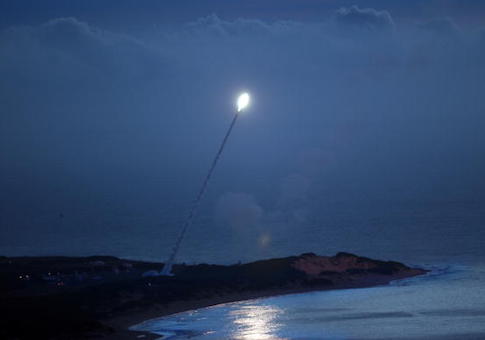After several months of escalating tensions between the United States and North Korea, Hawaiian leaders have begun to brief residents on emergency plans for a potential nuclear attack. But while the state's congressional delegation continues to place trust in Alaskan-based interceptors to shoot down an incoming missile, defense experts warn the existing system may be inadequate.
The United States today relies on ground-based interceptors in Alaska and California along with a floating sea-based radar system to detect and destroy missiles headed toward Hawaii, but the chief of U.S. Pacific Command told Congress in April these defenses "can be overwhelmed" and "could stand strengthening."
With North Korea's successful launch of an intercontinental ballistic missile in July, calls to fortify Hawaii's missile defense have grown more urgent.
The Pentagon is examining an expansion to the missile defense structure based in Hawaii and state lawmakers earlier this month held a closed-door meeting to review plans for dealing with nuclear warfare. Congress also passed several measures to shore up Hawaiian missile defense in the 2018 National Defense Authorization Act, including plans to build an advanced missile-tracking radar in the state. The billion-dollar radar, however, will not be ready until 2023.
Hawaii's congressional representatives have expressed confidence in the existing missile defense system and said efforts like the siting of a discriminating radar in the state and the expected 20 percent increase of missile interceptors in Alaska by the end of the year are adequate.
"I passed provisions in this year’s [NDAA] that prioritizes and continues funding for a permanent radar in Hawaii to strengthen the defense of Hawaii, as well as introduced legislation to increase ground-based interceptors in Alaska," Rep. Tulsi Gabbard (D., Hawaii) said in an email. "I am constantly seeking other interim options that will immediately strengthen the defense of Hawaii, as it sits within range of North Korea's missiles."
Gabbard, along with Rep. Colleen Hanabusa (D., Hawaii), has so far opposed the activation of the state's Aegis Ashore ballistic missile test site hosted at the Pacific Missile Range Facility (PMRF).
The Aegis Ashore ballistic missile defense system, considered the most advanced in the world, is a working prototype of the facility operationalized in Romania and the one to be deployed to Poland next year. Its activation offers an immediate, low-cost defense against North Korean missiles given its infrastructure is already in place.
But Hanabusa said operationalizing Aegis Ashore on Kauai would interfere with PMRF's missile testing and compromise the military's relationship with the local community. The base serves as a major employer on the island.
Harris, however, told Congress the activation of Aegis Ashore would have no impact on the site's missile testing mission.
Steve Bucci, a visiting fellow at the Heritage Foundation, said measures included in the 2018 NDAA are necessary long-term steps, but do not solve the near-term threat of a North Korean attack.
"I'd love to say we have six months, a year, five years, to build in the improvements and then that would be more than adequate, but that's just not the truth right now," Bucci told the Washington Free Beacon. "We have no idea when Kim Jong Un is going to shoot a missile at Hawaii."
He said the Defense Department needs to immediately layer already procured missile defense systems, including teaming up Aegis Ashore with SM-3 interceptors, like those already deployed in Japan, and associating it with the Terminal High Altitude Missile Defense (THAAD) system.
The Pentagon's Ballistic Missile Defense Review is underway and the Missile Defense Agency is in the process of examining several land-based radar alternatives in Hawaii to improve the state's ability to detect, track, and destroy North Korean missiles.
A spokesman for the Missile Defense Agency declined to comment on the ongoing review, but wrote in an email, "Hawaii and Guam are fully defended against threats from North Korea." Both are considered high-level targets for Pyongyang given the sheer volume of U.S. military presence.
Thomas Karako, director of the Missile Defense Project at the Center for Strategic and International Studies, agreed Hawaii is protected today, but said the state's radar system will likely need an update in "the next couple of years."
Any changes to the nation's missile defense architecture will be included in the Pentagon's review, which is not expected to be completed until the end of the year.
